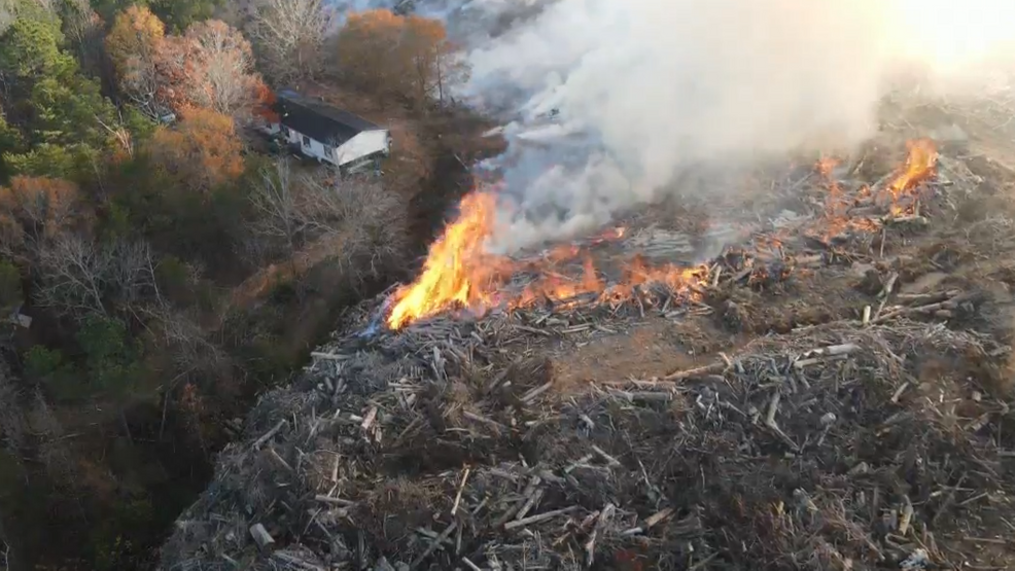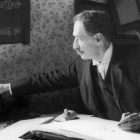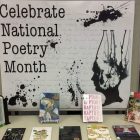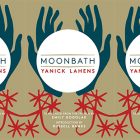Stories of Choice in the Face of Climate Change

A few weeks ago, I met a friend for coffee in downtown Birmingham, AL. It wasn’t long before it became clear that something was wrong. She was coughing—a nasty, persistent cough. She was apologetic, embarrassed even, but promised she wasn’t sick. She reassured me, “Well, it’s not catchable. It’s just the smoke from that damn fire.”
This was the first time I heard about the massive, twenty-five-acre fire burning less than twenty miles from my home. Since November 25, a private landfill had been burning in Moody, AL, the fire buried more than 100 feet underground and spreading smoke and debris across the area. Those closest to the fire had been forced from their homes due to the dangerous air quality. At her home in neighboring Trussville, the smoke levels weren’t as high, but it was enough that she was left with bronchitis. “It’s bad,” she said. “They don’t know when it’ll be put it out. We’re supposed to run air filters and stuff, and I am but…” She waved her hand as she stifled another cough. I could hear the echo of what goes unsaid echoing in my head: but I’m still coughing; but how much can the filters do; but what else can I do.
The answers—what other people have done—follow a pattern, one shaped by access to wealth. Buy painters tape to seal windows, purchase high quality air filters, stay with relatives, relocate to a hotel. My friend is lucky, in a way, she told me. With the filters she feels okay to stay.
Ever since our conversation, I’ve been thinking about the dilemma of staying and leaving. As those who have lived through environmental disasters know well, it’s a dilemma fundamentally shaped by access to wealth. Who can afford to leave? Who has enough wealth that their very presence meant that no landfill would ever be built near them in the first place?
The archive of this dilemma is haunting. A few years ago, when record droughts rocked through Europe, communities began to find centuries old “hunger stones” embedded in the drying riverbanks. They mark years of extreme drought when climate disaster fed economic crisis to form devastating levels of hunger and poverty. One stone carved in the Elbe River in the Czech Republic reads, “Wenn du mich siehst, dann weine.” If you see me, then weep. A list of dates follows: 1417, 1616, 1707, 1746, 1790, 1800, 1811, 1830, 1842, 1868, 1892, and 1893. It’s a record that resounds in its silence. Behind the hard outlining of dates are countless narratives of pain and loss. People unable to leave and condemned in their staying.
Hansel and Gretel is another such record, a story set during a time of great famine. While it was made famous in the nineteenth century Brothers Grimm telling, the story likely developed much earlier, after the Great Famine of 1315–17. Caused by periods of torrential downpour and a sudden drop in temperature, the famine killed 10 percent of Europe’s population and had devastating environmental and social consequences that echoed for at least the next century. Read through the lens of catastrophic climate change, it’s a familiar story transformed. The story tells how a young brother and sister were abandoned by their family in the woods and nearly devoured by a hungry witch. The child-eating witch might loom large in our minds, but it’s the famine that’s the first tragedy. So desperate are their father and stepmother to save themselves that they leave the siblings alone in the woods to fend for themselves. The story only ends in happiness when the witch is roasted, the stepmother dead, and enough wealth is accumulated that the little family, miraculously reunited, can live with enough ease to escape the famine.
One of the things I find most miraculous about Hansel and Gretel’s story is that when given the chance after escaping the witch, they return home. They don’t know that their stepmother is dead, or that their father will welcome them. They don’t know what the famine has left behind. They’ve faced so many challenges with cleverness as they traveled through the woods and tricked the witch. Surely their cleverness should tell them that only danger awaits them back home. But that’s not what matters most to them.
There’s another story, a popular fable, ascribed in the medieval and early modern periods to Aesop, called The Preaching of the Swallow. In it a prudent young swallow warns her fellow birds of a coming danger. The birds are all currently feasting on grain in a spring field, but, as the seasons pass, she warns that this feast will turn to danger. The field is owned by a fowler who will murder them all. The other birds hear but dismiss her concerns. In the end, the swallow is right. The next winter the fowler takes advantage of the birds’ hunger to lure them in with the empty promise of food. While the birds are distracted, he brutally murders them all. Only the swallow lives.
This fable seems a straightforward, if grim, morality tale, a warning against accepting good fortune too easily, perhaps, or a lecture on listening to sound advice. But in the hands of a skilled storyteller, we return to the dilemma of staying and going. Perhaps the most talented writer of this fable was the Scottish poet Robert Henryson. Born ca. 1460, Henryson lived about thirty years after the coldest winter in the last thousand years, during which it was so cold in Scotland wine bottles froze and six out of ten harvests failed.
Henryson writes the birds with great sympathy, emphasizing their need. The birds aren’t gluttons, gorging themselves on easy grain: “Thir small birdis, for hunger famischit near, / Full besie scraipand for to seik their fude, / The counsall of the swallow wald not heir… [These small birds, for hunger were near famished, / Full busily scraped to seek their food, / The counsel of the swallow did not want to hear.]” In a world of deprivation, where the abundance of summer quickly slides into the frozen desperation of fall, the birds are wise to eat while they can. In the winter, his poem seems to ask, is staying really the most foolish choice? What The Preaching of the Swallow dramatizes are the ways that need—that lack of abundance, of wealth—makes wisdom murkier. What counts as a prudent choice when choosing between a possible threat and starvation?
One more story. My grandmother tells me sometimes about the sulfuric rain that fell in her hometown in north Georgia when she was young. The rain was a byproduct of the nearby copper mines. I know she has described what the rains were like. The sudden destruction of fields, the poison lurking in the neighboring lakes. But what I remember most is another story, one almost too short to count as a story. It goes like this: she never had a high school reunion; you see, there were too few people who lived long enough for them to ever hold one.
I’ve been thinking about why that story haunts me. It’s devastating in its brevity. Like the hunger stones, it’s a story that says more in its silences. In them are the traces of long-lost hopes and future plans; in these silences we can hear the aching grief of a community left behind.
The fire currently burning in Moody is only one of many in an ever-expanding archive of stories of climate disaster. The thing about these archives is that they are cavernous. We begin to feel that we already know their ending. In these cavernous spaces everything begins to merge together, and the particular narratives, hopes, and fears, of the people who lived through them become lost.
I’ve been thinking about these archives of staying and going not so much because they reveal some new, previously hidden insight—we all know or we all should know by now that access to wealth mitigates environmental disaster—but because of the record they leave carved in language and story. Each story is unique, telling us different things: a cough, a stone, a witch, a swallow, a reunion. Breadcrumbs leading us to the individuals who told them. Narratives like these flesh out the nuances of living alongside environmental disaster. Choices that seem simple or easily fixable refocus to show us the people who lived through them.



